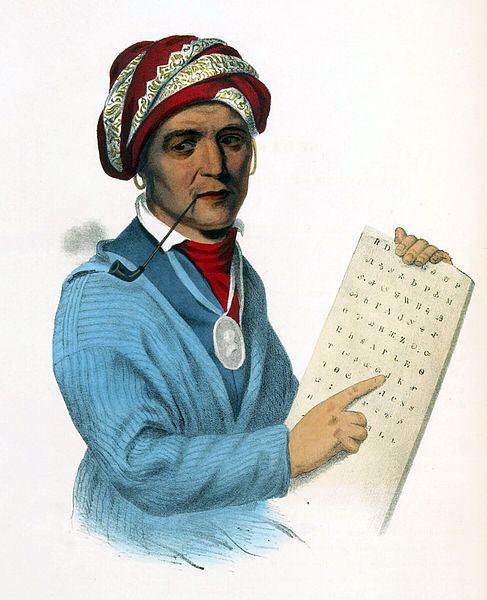Famous Native Americans


Sequoyah’s mother was Cherokee and his father was a white trader. Sequoyah lived with his mother near the Cherokee village of Taskigi in the Smoky Mountains of Tennessee. The medicine men taught Sequoyah how to find the special herbs and roots they used to heal the sick.
When Sequoyah went to other villages to trade, he saw silversmiths. Sequoyah brought tools home to use in shaping silver. He became very skilled at shaping silver and made beautiful knives, spoons, and jewelry.
Sequoyah was sad because the white settlers were coming more and more to the Cherokee land. The Cherokee were adopting the white settlers’ ways. After Sequoyah’s mother died, he wandered from village to village for two years. He finally settled down in Alabama in the village of Coosa. In Coosa, Sequoyah married a Cherokee woman. He started working as a blacksmith and a silversmith.
Sequoyah had a dream that he could take each Cherokee word and write it down. Sequoyah felt writing down the Cherokee language was important because the white settlers were making treaties on paper that the Cherokee could not read.


In 1812, Sequoyah went to war on the side of the Americans during the War of 1812. After returning home from the war, Sequoyah spent most of his time working on the Cherokee syllabary. After Sequoyah’s home filled up with piles of pictures, he learned he would have to find an easier way to write. One day, while walking with his daughter Ah-yo-ka, Sequoyah learned by listening to the birds that words were made up of sounds and that some words had the same sounds.
The Cherokee remembered Sequoyah spending time with the medicine men. They thought that he was making bad spells. One day, while Sequoyah was walking in the woods with Ah-yo-ka, the Cherokee set fire to Sequoyah’s cabin. When Sequoyah returned and found his cabin burned, he carefully wrote his Cherokee syllabary on a large piece of buckskin. Sequoyah knew he must leave Alabama. He and Ah-yo-ka traveled west to the Oklahoma and Arkansas territory. On the way west, Sequoyah and Ah-yo-ka met a Cherokee woman named Sally. She believed in Sequoyah’s dream.
Sequoyah built a cabin in the wilderness. He continued to work on his syllabary. When it was completed, the syllabary contained 86 symbols. Sequoyah decided to return to the East and show his completed syllabary to the Tribal Council. When Sequoyah showed the men of the Tribal Council his syllabary, they thought that he and Ah-yo-ka were trying to trick them. Sequoyah said he would prove to the men that he was not tricking them. He told the Cherokee to take Ah-yo-ka to the other side of the village. They could then tell him something to write down. Ah-yo-ka would then come in and read it to the Tribal Council. When Ah-yo-ka returned, she read the words and the Tribal Council believed in Sequoyah’s syllabary.
Everyone wanted to learn how to read and write. Sequoyah and Ah-yo-ka spent many months teaching the Cherokee. After almost all the Cherokee had learned to read and write, they started their own newspaper called the Cherokee Phoenix. The Tribal Council gave Sequoyah a silver medal with two crossed pipes carved on it. The symbols showed how Sequoyah had brought Eastern and Western Cherokee together.
Sequoyah was the first person in history to invent a written language alone. The Cherokee people were able to use the written language to write down the old stories. The syllabary helped the people understand each other better. In 1830, gold was discovered in the eastern territory. The white settlers forced the Cherokee to move westward onto new lands. One-third of the Cherokee died in their travels west, known as the “Trail of Tears.”
